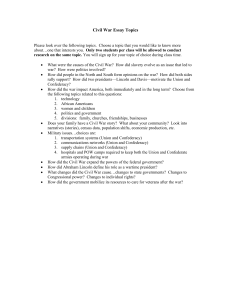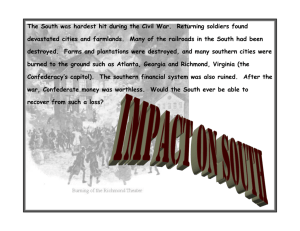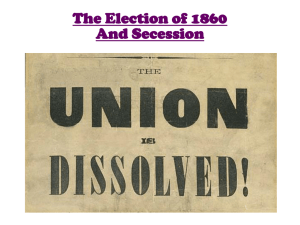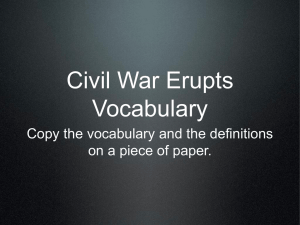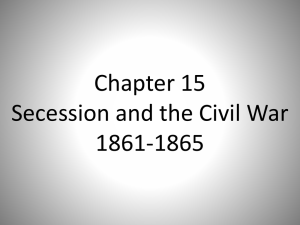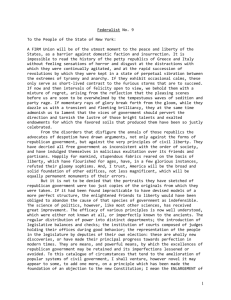Could the South have won the War?
advertisement
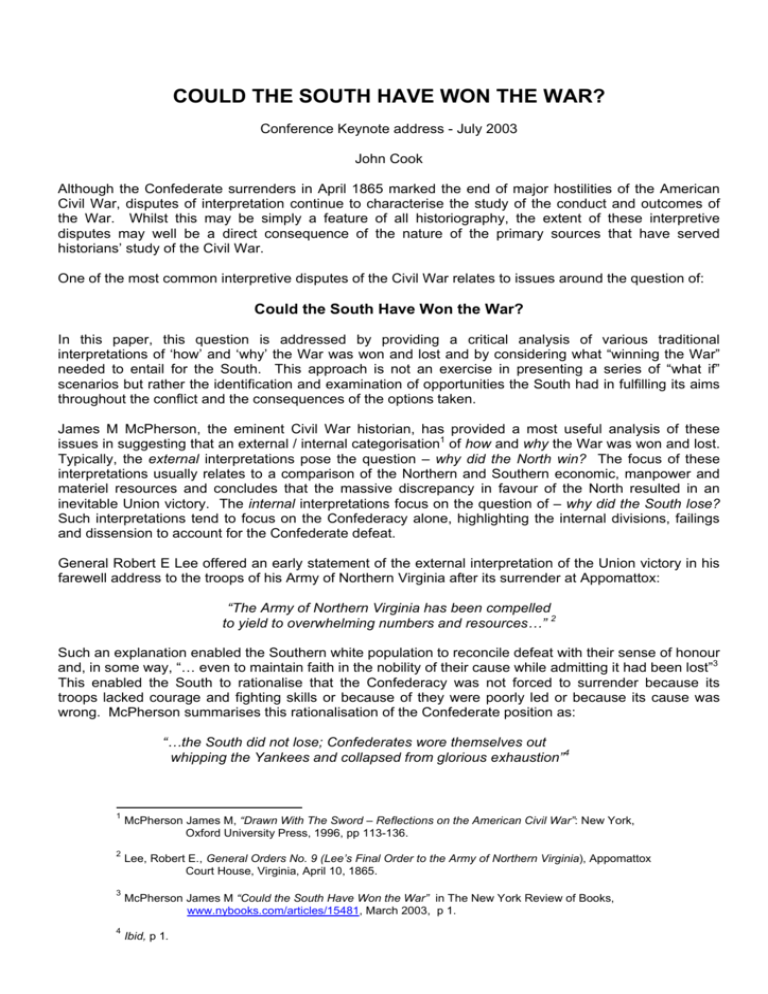
COULD THE SOUTH HAVE WON THE WAR? Conference Keynote address - July 2003 John Cook Although the Confederate surrenders in April 1865 marked the end of major hostilities of the American Civil War, disputes of interpretation continue to characterise the study of the conduct and outcomes of the War. Whilst this may be simply a feature of all historiography, the extent of these interpretive disputes may well be a direct consequence of the nature of the primary sources that have served historians’ study of the Civil War. One of the most common interpretive disputes of the Civil War relates to issues around the question of: Could the South Have Won the War? In this paper, this question is addressed by providing a critical analysis of various traditional interpretations of ‘how’ and ‘why’ the War was won and lost and by considering what “winning the War” needed to entail for the South. This approach is not an exercise in presenting a series of “what if” scenarios but rather the identification and examination of opportunities the South had in fulfilling its aims throughout the conflict and the consequences of the options taken. James M McPherson, the eminent Civil War historian, has provided a most useful analysis of these issues in suggesting that an external / internal categorisation1 of how and why the War was won and lost. Typically, the external interpretations pose the question – why did the North win? The focus of these interpretations usually relates to a comparison of the Northern and Southern economic, manpower and materiel resources and concludes that the massive discrepancy in favour of the North resulted in an inevitable Union victory. The internal interpretations focus on the question of – why did the South lose? Such interpretations tend to focus on the Confederacy alone, highlighting the internal divisions, failings and dissension to account for the Confederate defeat. General Robert E Lee offered an early statement of the external interpretation of the Union victory in his farewell address to the troops of his Army of Northern Virginia after its surrender at Appomattox: “The Army of Northern Virginia has been compelled to yield to overwhelming numbers and resources…” 2 Such an explanation enabled the Southern white population to reconcile defeat with their sense of honour and, in some way, “… even to maintain faith in the nobility of their cause while admitting it had been lost”3 This enabled the South to rationalise that the Confederacy was not forced to surrender because its troops lacked courage and fighting skills or because of they were poorly led or because its cause was wrong. McPherson summarises this rationalisation of the Confederate position as: “…the South did not lose; Confederates wore themselves out whipping the Yankees and collapsed from glorious exhaustion”4 1 McPherson James M, “Drawn With The Sword – Reflections on the American Civil War”: New York, Oxford University Press, 1996, pp 113-136. 2 Lee, Robert E., General Orders No. 9 (Lee’s Final Order to the Army of Northern Virginia), Appomattox Court House, Virginia, April 10, 1865. 3 McPherson James M “Could the South Have Won the War” in The New York Review of Books, www.nybooks.com/articles/15481, March 2003, p 1. 4 Ibid, p 1. It is this particular interpretation of the outcome of the War that became a cornerstone of the so-called Myth of the Lost Cause, an interpretation that, even today, still sustains some Southerners and neoConfederates, worldwide. The “disparity of resources” explanation for the inevitable outcome of the War, however, is not restricted to Southern historians or apologists. Writing at the time of the War’s Centennial in the early 1960s, the historian, Richard Current, presented a succinct version of this interpretation when, after reviewing the statistics of the North’s “…overwhelming numbers and resources”, he concluded that: “… Surely, in view of the disparity in resources, it would have taken a miracle, a direct intervention of the Lord on the other side, to enable the South to win. As usual, God was on the side of the heaviest battalions” 5 More recently, Shelby Foote reiterated this position in an interview as part of Ken Burns’ television series ‘The Civil War’ (1990), where he asserted that: “…the North fought the War with one hand behind its back… (If necessary) the North would have brought the other arm out from behind its back … I don’t think that the South ever had a chance to win the War.” Whilst these views expressed by Current and Foote might seem plausible initially, there is considerable questioning amongst modern historians that the North’s “overwhelming numbers and resources” meant that a Union victory was inevitable. If this ‘resources superiority’ meant an inevitable Federal victory, it can be argued that the Confederate leadership in 1861 has much to answer for in going to war. Their actions in leading the Confederate States into a war where defeat was inevitable would have been both criminally negligent and a display of unbelievable and gross arrogance. In declaring war, however, the Confederate States were confident of victory and certainly there were sound grounds for this confidence. There were numerous examples of small countries that had been able to win or defend their independence from much more powerful nations6. Indeed, earlier generations of Americans had gained their independence from Great Britain in 1781 with a significantly smaller resource base in relation to their enemy than that which existed for the Confederacy vis-à-vis the Union in 1861. Essentially, the war in which the Confederacy needed to engage from 1861 involved the protection from conquest of territory it controlled and the preservation of its armies from outright defeat. To “win” such a war, the Confederacy was not required to destroy the Union armies and its infrastructure or invade and conquer the North. It needed only to hold out long enough for the North to recognise that the “price” for conquering the South and defeating its armies was too great just as the British had concluded some 80 years earlier. The London Times in 1862 expressed the widely held view that the United States would not be able to conquer the Confederate States when its military analyst reported: “No war of independence ever terminated unsuccessfully except where the disparity of force is much greater than it is in this case…Just as England during the revolution had to give up conquering the colonies so the North will have to give up conquering the South” 7 The fact that this was a prevailing view was seen as supporting the Confederacy’s initiatives for seeking overseas recognition, particularly by the European powers. This was something sought by the 5 Current Richard N., “God and the Strongest Battalions” in David Donald (ed), Why the North Won the Civil War: New York, Collier Macmillan Publishers,, 1962, p 32. 6 In this regard, the examples of the Swiss against the Hapsburg Empire in the 14th Century, the Netherlands against Spain in the 16th Century, and Greece against the Ottoman Empire in the 1820s provided good exemplars of what could be achieved by countries seeking their independence. Today’s historians can look, also, at the Vietnam experience of the 1950s, 60s and 70s to reinforce the fallibility of the “biggest battalions” thesis. 7 London Times, August 29, 1862. 2 Confederacy throughout the War as one of the means of convincing the North that the price for victory would be too much to pay. From the Union perspective the first two years of conflict had changed not only the philosophy of the War as a whole, but also the very reasons the War was being raged. By 1863, the strategy of Lincoln’s Government to win the War was essentially reduced to three things. First, they had to conquer and occupy the huge area of the Confederate States, an area as large as the whole of Western Europe. Second, they had to cripple the South’s infrastructure and resources. Last, they had the difficult task of destroying the Confederate armies as an effective fighting force. Given these parameters, the Union’s superior manpower and materiel resources were simply not enough to guarantee inevitable victory. Put another way, the Union’s superior resource base was a necessary but not sufficient condition to ensure victory. Indeed, America’s Civil War was to demonstrate clearly that superior manpower and resources do not win wars unless there is the will and skills to use them. Even after the War many senior Confederate commanders held to the belief that the Union’s superior resource base did not render the War beyond victory for the Confederates. Joseph E Johnston, one of the Confederacy most senior general officers stated that the South had not been “…guilty of the high crime of undertaking a war without the means of waging it successfully”8 and Pierre G T Beauregard made a similar claim some ten years later in stating that: “No people ever warred for independence with more relative advantages than the Confederates”9 Whilst Johnston and Beauregard both blamed the South’s failure in the War on Jefferson Davis’s inept leadership, Davis replied in kind by attributing their erratic and inadequate generalship as a major factor in the Confederate defeat. Each of these is a classic “internal interpretation” of the War’s outcome10 and, although such interpretations are flawed, they still receive considerable attention, mainly to counter the effect of the defects of the “overwhelming numbers and resources” interpretations. There were at least four perceived advantages the South had when war broke out to offset the North’s manpower and materiel resources’ advantages. First, there was a psychological advantage associated with the high ideal of independence and fighting to protect their homes and way of life. Such motivations were considered to give the Southern population a more determined fighting spirit than the North could ever hope to attain. Second, the geography of the South with its rivers, mountains and swamp areas “were equivalent to successive lines of fortifications” and were coupled with good interior lines that could greatly enhance the efficient and effective deployment of their armies. Third, although the North had a greater resource base than the South, it is interesting to note that, at the beginning of the War, the South was better resourced in the “necessities of life”. For example, their per-capita production of corn and livestock outpaced that in the North. Fourth and most important, they had cotton! This resource may be considered as either an economic or a diplomatic factor that, potentially, had great importance for the survival of the fledgling Confederacy. In cotton, the Confederacy possessed a cash crop of considerable value but, as the War proceeded, they not only reduced its planting but also burned some of the bales ready for shipment and discouraged exports overseas. As one historian noted: 8 Johnston Joseph E., Narrative of Military Operations During the Civil War: New York, Appleton, 1874. p 421. 9 Beauregard P G T “The First Battle of Bull Run” in Johnson R U and Buel C C (eds), Battles and Leaders of the Civil War Volume I: Century, 1887, p 222. 10 For the most recent “internal” study of the Confederacy, see: Davis Wm C., Look Away! A History of the Confederate States of America: New York. Simon and Schuster, 2003. In this book, the author, Davis, attributes the Confederate defeat in the War to poor leadership in both the military and political areas. Factionalism, dissension and bickering at various levels between men with giant egos and thin skins all contributed to the Confederacy’s defeat. In this version of the Confederate history only Lee and Jackson are untainted. 3 “Instead of making best use of this resource, the Davis government did everything in its power to make it useless” 11 The logic underpinning these decisions taken regarding cotton is difficult to understand and sustain! The Confederate efforts to “win” the War and, thus, gain independence focused on an essentially defensive strategy of “winning by not losing.” Throughout the War this involved a number of distinct military strategies, which for purposes of analysis may be considered as: STRATEGY 1 – Davis 1 or “Cordon Defence” Strategy: This strategy was used for much of the first year of the War and involved positioning troops around the whole of the periphery of the Confederacy in an attempt to defend all of its territory. Whilst this strategy had much to commend it politically12, militarily it led to disaster when, in 1862, Federal forces, as an aftermath of some most significant victories in the Western Theatre13, had little trouble breaching the thin defence line along the border. In the wake of these Federal incursions, the South abandoned their efforts to hold all of their territory. STRATEGY 2 – Davis 2 or the “Offensive – Defensive” Strategy: As a consequence of the failure of the previous strategy, the Confederate government abandoned less important areas to concentrate its resources in defending strategically key points. They were able to use their “interior lines”, particularly the railways, to move their forces quickly to defend points the Federals might attack, or assemble a force to mount an offensive of their own. Essentially, this so-called “Offensive – Defensive” strategy involved adopting a defensive stance but striking at the enemy when favourable conditions presented themselves. STRATEGY 3 – Robert E Lee or the “OFFENSIVE – Defensive” Strategy: Essentially a variant of the previous strategy with a greater emphasis on the “Offensive” part of the “Offensive – Defensive”, this strategy was advocated by Robert E Lee during the winter of 1862 –1863. He suggested that the Confederates should seize the initiative and seek to throw the Federals off balance by winning a decisive victory in the field, thus convincing the North that they should abandon its attempts to preserve the Union. Lee had come to recognise that the Confederacy did not have the manpower, materiel or financial resources to conduct a protracted war and that, because of its defeats in the Western Theatre, was already losing the war. The only way to reverse this, therefore, was to have a great military victory that would demoralise the Northern population and enable the Confederate armies to dictate peace terms enabling the South to gain the independence it sought. Such a strategy had considerable risk associated with it and with our wisdom of hindsight was to fail. The two Confederate invasions of the North did not bring the decisive victories sought and after Gettysburg in 1863, Lee did not have the men (or the necessary government support) to advance north of the Potomac for a third time. This situation reveals the major flaw in Lee’s ‘initiative” strategy – the effect of the cumulative loss of the Confederacy’s scarcest resource – its men! STRATEGY 4 – Joseph E Johnston or the “Offensive – DEFENSIVE” Strategy: This strategy is also a variant of Strategy 2 with the major emphasis being placed on the “Defensive” aspect only of the “Offensive – Defensive”. Developed for the Atlanta Campaign in 1864 by Joseph E Johnston, this strategy involved placing the Confederate force in a naturally strong position, enhanced by additional field defences and fortifications and wait for the enemy to attack. If, as occurred in this Campaign, the enemy did not attack but went around the flanks, Johnston would withdraw his force, say 15–20 miles, to another defensive position and repeat the operation. In doing so, Johnston later asserted that with this strategy his army remained intact, that he would eventually strike out at the enemy if the opportunity presented itself and would in effect “win by not losing”. Unfortunately, during the Atlanta Campaign, Davis replaced 11 B J Hendrick, quoted in Donald, David (ed), Why the North Won the Civil War: New York, Collier Macmillan Publishers, 1962, p 19. 12 Although George Washington had successfully used a strategy that sacrificed territory to the British during the Revolutionary War, over several generations the Southern population had become accustomed to the protection of its lands by a strong United States. Accordingly, it is unlikely they would have accepted losses of territory, as occurred in the War of Independence. Thus, protection of the whole of Southern territory was a political imperative initially. 13 These Union victories included the battles at Mill Springs (Jan 19. 1862), Fort Henry (Feb 6, 1862), Fort Donelson (Feb 13-16, 1862), Pea Ridge (Mar 7-8, 1862) and New Orleans (Apr 18-25, 1862). 4 Johnston with John Bell Hood and it remains an unanswered question if Johnston’s army would have finally taken the battle to Sherman’s forces. STRATEGY 5 – Davis 3 Strategy: Although never used, President Davis had proposed this strategy at the very end of the War and it is included here only for reasons of completeness. The strategy involved the Confederate forces undertaking protracted guerrilla warfare. Fortunately, the senior Confederate commanders and, in particular, Lee, rejected Davis’s proposed strategy and it was never implemented. To properly address the issues relating to the conduct of the War by either the Confederates or the Federals, it is essential that the boundaries of the subject be clarified by specifying what is meant by the terminology used. To this end, a set of definitions of commonly used terms for the five levels of any nation’s conduct of a war is now explained. First, it is important to note that with respect to the often loosely defined construct of strategy the distinction between National Strategy and Military Strategy. The term ‘National Strategy’ embraces the concepts of ‘war aims’ and ‘war policies’, each of which are essentially political in their nature and, therefore, are determined by government. War aims refer to ‘the objects that carried the nation into war and which must be achieved for victory’ whereas war policies are essentially ‘the guidelines adopted by the nation for the use of its resources, both human and physical.’ ‘Military Strategy’ is then the military (and naval) plans adopted within the policy guidelines for obtaining victory. At the next level down there are ‘tactics’ and ‘logistics’. In this context, the term ‘tactics’ refers to ‘the method adopted for applying force in battle’ and ‘logistics’ is ‘the program for moving and supplying forces during and between battles’. The more these levels are congruent, in harmony or consistent, the more likely there will be a successful outcome or victory for the nation. Conversely, if the National Strategy, as determined in the political arena, and the Military Strategy, as determined by the Theatre Commanders, are not consistent or are in conflict, the less likely is the army is to be successful. Furthermore, no matter what aims and policies a commander is given or pursues, he cannot deploy more resources than are at his disposal. Any strategy devised that does not take the given resources into account is by definition unrealistic and likely to result in wastage, loss and failure. During the Civil War the North’s national strategy changed as the War changed from a limited conflict to restore the Antebellum status quo to one designed to destroy slavery and the social order it supported. As McPherson notes in discussing this: “… Lincoln’s genius as commander-in-chief was his ability to shape and define this expanding national strategy and eventually to put in place, after three rocky years, a military strategy and military leaders to carry it out” 14 Jefferson Davis’s performance as commander-in-chief suffers in comparison, partly because the Confederacy lost the War but as much because of his shortcomings as a leader at a national level, particularly his inability to work with his critics for a common cause. In this, he stands in stark contrast to Lincoln and nothing Davis said or wrote during the War came close to Lincoln’s famous addresses that clearly expressed and communicated his government’s national strategy to all. That said, it should be noted that Davis, in his first message to the Confederate Congress, did specify clearly and concisely Confederate national strategy: “ We seek no conquest, no aggrandizement (sic), no concession of any kind from the State with which we were lately confederated; all we ask is to be left alone” 15 14 James M McPherson, “Failed Southern Strategies” in Crowley, Robert (ed), With My Face to the Enemy – Perspectives on the Civil War: New York, G P Putnam’s Sons, 2001, p 76. 15 Ibid, p 77. 5 Such a strategy is a purely defensive one and was based on the fact, often overlooked, that at the beginning of the War, the Confederacy controlled almost all of the territory that it claimed, a feature that was and remains quite uncommon with independence movements. Furthermore, by May 1861, the Confederacy had a functional government and a strong army approaching full mobilisation and with few exceptions16 no enemy within its borders. To win its War, all the Confederacy had to do was to defend and hold what it already had! Well, what went wrong? With the advantage of hindsight, historians are able to highlight a number of factors that, although not critical individually, contributed in a cumulative manner to bring about the eventual Confederate defeat. Interestingly, there is no consensus amongst present-day Civil War scholars of the relative importance or quantum of these factors. The factors that are commonly used in this context are: 1. The principle of ‘State sovereignty’ that underpinned the establishment of the Confederacy and the associated provincialism that characterised both the organisation of its armies and the deploying of its troops to various theatres of war; 2. The lack of political acumen that Davis had vis-à-vis Lincoln in achieving the Confederacy’s aims; 3. The dysfunctional relationship that Davis had with most of his generals; 4. With some notable exceptions, the quality of Confederate officers at the higher levels of command were not able to match the Federal commanders that eventually emerged to win the War; 5. The economic and diplomatic mistakes made by the Confederacy in negotiations with the European powers, including those in relation to its cotton resources; 6. An associated misreading of the likelihood of foreign intervention in support of the Confederacy; 7. The disparity in manpower and materiel resources with the North, noting, however, that such disparities in themselves did not render defeat inevitable; 8. The manpower resources the Confederacy had available to it vis-à-vis the territory it needed to defend; 9. The diminishing pool of manpower resources that the Confederacy could call upon as the War progressed; 10. The most primitive of logistical systems that prevented the effective use of what limited resources that were available to them; 11. The lack of heavy industry, particularly with respect to armaments, located in the South and to which the Confederacy had direct and easy access; 12. The lowered morale and lack of support for the War by the Southern population as the War progressed to its conclusion, 16 These exceptions were Fort Monroe, Virginia and Fort Pickens on an island off Pensacola, Florida. 6 Although some of these factors were unique to the Confederacy, there are others that are shared with the Federals. For example, the problems that Davis had with his generals were mirrored in Lincoln’s relationships with some of his senior officers. Davis might have had his Johnston, Bragg, Hood, Polk and Beauregard but Lincoln had his own problems with McClellan, McDowell, Burnside, Hooker and Fremont. In a similar manner, the lack of support for pursuing the War and the actions of the Copperheads throughout the War was the source of considerable angst for Lincoln, particularly in 1864 in the lead-up to the Presidential elections of that year. Notwithstanding these factors, the Confederacy had a real chance of “winning”, that is to say, gaining its independence from the Union at a number of times during the War but, for various reasons, were not successful. Essentially, this Confederate “victory” might have been achieved in one of three contexts that would have forced the Union into negotiations with the Confederacy and allow the Rebels to dictate, to a major extent, the terms of the resulting peace. These contexts were: • By a decisive Confederate military victory that destroyed the Union armies; • By foreign intervention in support of the Confederacy, particularly by Britain and/or France; and • By outlasting the enemy and forcing the Union to negotiate following a Lincoln defeat at the 1864 presidential elections. Although during the first two years of the War the Confederates had a number of significant victories in the Eastern theatre of operations, their performance in the Western theatre was characterised by a succession of defeats. Unless these defeats could be halted, which they weren’t, the Confederacy was doomed, which it was! In reality, the only chance of the decisive victory needed to bring the Union to the negotiating table would have been by marching on Washington and threatening the seat of government immediately following the First Battle of Manassas (July 1861) when the Union army was in disarray. At that time, however, neither side was experienced in mobilising nor deploying effectively the large bodies of troops that became the norm in the Civil War and an opportunity was lost. As has been noted previously, at the beginning of the War none of European powers believed that the Union had enough manpower resources to successfully invade and conquer the seceding Confederate States and, as a consequence, foreign intervention was openly discussed. As the War proceeded, however, the succession of Union victories in the Western theatre diminished this possibility of intervention. In the Eastern theatre, Lee’s invasion into Maryland culminating in the Battle of Antietam (or Sharpsburg as it was known to the Confederates) on September 17, 1862 provided the best chance of gaining overseas recognition. Following the significant Confederate victories throughout the summer of 1862, the Union was on its knees and the British were talking of recognising the Confederacy and brokering a negotiated peace between North and South. A Southern victory at Antietam would enable Lee to directly threaten Washington and hasten the moves for Confederate recognition. It was not to be Antietam turned out to be the bloodiest single day in American history with more than 6,000 soldiers killed. The battle ended in a stalemate forcing Lee to withdraw south out of Maryland but with his forces intact. Although McClellan did not pursue the Rebels with a view to destroying Lee’s army, Antietam was an important strategic Union victory. Not only did it prevent a Southern invasion of the North’s territory that would threaten Washington, it also gave Lincoln the victory he was seeking to enable him to deliver his Preliminary Emancipation Proclamation and crushed Confederate hopes of British intervention. Lee’s second invasion of the North in the following year that culminated in the Confederate defeat at the three-day Battle of Gettysburg on July 3, 1863 dashed forever any hope of overseas recognition. Although Lee’s Army of Northern Virginia remained a viable fighting force for nearly two more years of the War, after Gettysburg it was never strong enough to invade the North again. In 1864, the War was still going badly for the Federals even after Grant assumed overall command of the Union forces. The huge Union casualty rates during the Overland Campaign led to the Northern 7 population’s morale being at an all time low. Even Lincoln himself did not believe that he would be reelected in November and made plans for his successor and the new government. Fortunately for the Union, the Confederates were continuing their pattern of defeats in the Western theatre of operations and Sherman’s capture and occupation of Atlanta in September 1864 saw the beginning of a turn in public opinion that was to see Lincoln defeat McClellan in the presidential elections in November. With McCellan’s defeat, the Confederacy lost its last chance of the possibility of a negotiated peace and Lincoln was able to pursue his goal of a Confederate surrender that was to become a reality in April 1865. Whilst ‘yes’ is the simple answer to the question posed as the title of this paper – ‘Could the South Have Won the War?’ - the fact remains that it didn’t! Some of the reasons for and factors associated with this failure of the South to win the War and, thus, gain its independence have been canvassed in this paper. In considering these, it should be noted that there is little consensus amongst Civil War scholars, both professional and amateur, of the relative importance or impact of these factors in determining the final outcome of the War. As a consequence, the question will remain a continuing source of discussion, disputation and argument amongst all that are interested in America’s Civil War and its outcomes. For those who still seek a simple answer, however, to the associated question of why the South failed in its bid for independence, they can do no better than look to the words of General George Edward Pickett, CSA, albeit in another of context, when he said: “… I always thought the Yankees had something to do with it” BIBLIOGRAPHY Beauregard, P. G. T., “The First Battle of Bull Run” in Johnson, R.U. and Buel C. (eds) Battles and Leaders of the Civil War, Volume 1: Century, 1887. Crowley, Robert, (ed), “With My Face to the Enemy – Perspectives on the Civil War”: New York, P G Putnam’s Sons, 2001 Davis, Wm C., Look Away – A History of the Confederate States of America”: New York, Simon and Schuster, 2003. Donald, David, (ed) “Why the North Won The Civil War”: New York, Collier Macmillan Publishers, 1962. Johnston, Joseph E., “Narrative of Military Operations During the Civil War”: New York, Appleton, 1874, reprinted by De Capo Press, 1959.. McPherson, James M, “Drawn With The Sword – Reflections on the American Civil War”: New York, Oxford University Press, 1996. --“Could the South Have Won the War” in The New York Review of Books, accessed through www.nybooks.com/articles/15481 , March 2003 --“Battle Cry Of Freedom – The Civil War Era”: New York, Oxford University Press Inc., 1988. 8
